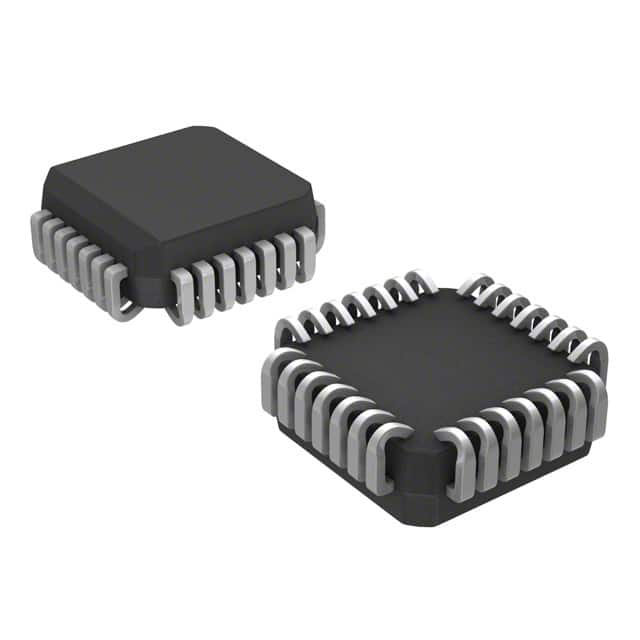Szczegóły produktu można znaleźć w specyfikacjach.

ATF750C-10JI
Product Overview
Category
ATF750C-10JI belongs to the category of programmable logic devices (PLDs).
Use
It is primarily used for digital circuit design and implementation.
Characteristics
- Programmable: The ATF750C-10JI can be programmed to perform specific functions.
- Versatile: It can be used in a wide range of applications due to its programmability.
- High-speed operation: The device operates at a speed of 10 nanoseconds.
Package
The ATF750C-10JI comes in a 44-pin PLCC (Plastic Leaded Chip Carrier) package.
Essence
The essence of ATF750C-10JI lies in its ability to provide flexible and customizable digital circuit solutions.
Packaging/Quantity
The ATF750C-10JI is typically packaged in reels or tubes, with a quantity of 25 units per reel/tube.
Specifications
- Technology: CMOS
- Maximum Operating Frequency: 10 MHz
- Number of Logic Elements: 750
- Number of Input/Output Pins: 36
- Supply Voltage: 5V
- Operating Temperature Range: -40°C to +85°C
Detailed Pin Configuration
The ATF750C-10JI has a total of 44 pins. Here is a detailed pin configuration:
- VCCIO
- I/O0
- I/O1
- I/O2
- I/O3
- I/O4
- I/O5
- I/O6
- I/O7
- I/O8
- I/O9
- I/O10
- I/O11
- I/O12
- I/O13
- I/O14
- I/O15
- I/O16
- I/O17
- I/O18
- I/O19
- I/O20
- I/O21
- I/O22
- I/O23
- I/O24
- I/O25
- I/O26
- I/O27
- I/O28
- I/O29
- I/O30
- I/O31
- I/O32
- I/O33
- I/O34
- I/O35
- GND
- VCC
- CE
- OE
- WE
- RESET
- CLK
Functional Features
- Programmability: The ATF750C-10JI can be programmed to implement various digital functions.
- High-speed operation: It operates at a speed of 10 nanoseconds, enabling rapid data processing.
- Flexible I/O configuration: The device offers 36 input/output pins, allowing for versatile connectivity options.
Advantages and Disadvantages
Advantages
- Customizability: The ATF750C-10JI can be tailored to specific application requirements.
- Versatility: It can be used in a wide range of digital circuit designs.
- High-speed operation: The device enables fast data processing.
Disadvantages
- Limited logic elements: With only 750 logic elements, complex designs may require additional devices.
- Power consumption: The ATF750C-10JI consumes power during operation, which may be a concern in low-power applications.
Working Principles
The ATF750C-10JI utilizes programmable logic elements to implement digital functions. These logic elements can be interconnected and configured through programming to create desired circuit functionality. The device operates based on the principles of combinatorial and sequential logic, allowing for the realization of complex digital systems.
Detailed Application Field Plans
The ATF750C-10JI finds applications in various fields, including: 1. Industrial automation 2. Telecommunications 3. Consumer electronics 4. Automotive systems 5. Medical devices
In industrial automation, it can be used for control and monitoring purposes. In telecommunications, the device can be employed in data transmission and signal processing. Consumer electronics benefit from its versatility in implementing different digital functions. Automotive systems utilize the ATF750C-10JI for various control and sensing applications. Medical devices can also incorporate this PLD for data processing and control tasks.
Detailed and Complete Alternative Models
Some alternative models to ATF750C-10JI include: 1. ATF1502ASV-15JC 2. ATF16V8BQL-15PU 3. ATF22V10BQZ-20PC 4. ATF2500C-20PU 5. ATF16V8BQL-25SU
These models offer similar programmable logic capabilities but may differ in terms of pin configuration, speed, and other specifications. The choice of an alternative model depends on specific project requirements and
Wymień 10 typowych pytań i odpowiedzi związanych z zastosowaniem ATF750C-10JI w rozwiązaniach technicznych
Sure! Here are 10 common questions and answers related to the application of ATF750C-10JI in technical solutions:
Q: What is ATF750C-10JI? A: ATF750C-10JI is a specific model of programmable logic device (PLD) manufactured by Microchip Technology Inc.
Q: What are the key features of ATF750C-10JI? A: Some key features of ATF750C-10JI include 750 usable gates, 10 ns maximum propagation delay, and 5V operation.
Q: What are the typical applications of ATF750C-10JI? A: ATF750C-10JI is commonly used in various digital systems, such as industrial control systems, telecommunications equipment, and consumer electronics.
Q: How can I program ATF750C-10JI? A: ATF750C-10JI can be programmed using industry-standard programming tools, such as a programmer or a development board with programming capabilities.
Q: Can ATF750C-10JI be reprogrammed after it has been programmed once? A: No, ATF750C-10JI is a one-time programmable device and cannot be reprogrammed once it has been programmed.
Q: What is the power supply requirement for ATF750C-10JI? A: ATF750C-10JI operates on a 5V power supply.
Q: Does ATF750C-10JI support different voltage levels for input/output signals? A: Yes, ATF750C-10JI supports both 5V and 3.3V input/output signal levels.
Q: Can ATF750C-10JI interface with other components or microcontrollers? A: Yes, ATF750C-10JI can interface with other components or microcontrollers through standard digital interfaces, such as GPIO pins.
Q: What is the maximum operating frequency of ATF750C-10JI? A: The maximum operating frequency of ATF750C-10JI is typically specified by the manufacturer and depends on various factors, including the design and implementation of the system.
Q: Are there any specific design considerations when using ATF750C-10JI in technical solutions? A: Yes, some design considerations include proper power supply decoupling, signal integrity, and ensuring compatibility with other components in the system.
Please note that these answers are general and may vary depending on the specific requirements and documentation provided by the manufacturer.

